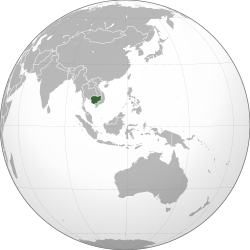
Back جمهورية الخمير Arabic Кхмерская Рэспубліка Byelorussian Кхмерска република Bulgarian República Khmer Catalan Khmerská republika Czech Republik Khmer German República Jemer Spanish Khmer Errepublika Basque جمهوری خمر Persian Khmerin tasavalta Finnish
This article needs additional citations for verification. (October 2017) |
Khmer Republic | |||||||||||
|---|---|---|---|---|---|---|---|---|---|---|---|
| 1970–1975 | |||||||||||
| Motto: | |||||||||||
Anthem:
| |||||||||||
 Location of the Khmer Republic | |||||||||||
| Capital and largest city | Phnom Penh | ||||||||||
| Official languages | |||||||||||
| Religion | Buddhism (official)[1] | ||||||||||
| Demonym(s) | |||||||||||
| Government | Unitary presidential constitutional republic (de jure)[2] Unitary semi-presidential constitutional republic under a military dictatorship (de facto)[citation needed] | ||||||||||
| President | |||||||||||
• 1970–1972 | Cheng Heng | ||||||||||
• 1972–1975 | Lon Nol | ||||||||||
• 1975 | Saukam Khoy (acting) | ||||||||||
• 1975 | Sak Sutsakhan[a] | ||||||||||
| Prime Minister | |||||||||||
• 1970–1971 | Lon Nol | ||||||||||
• 1971–1972 | Sisowath Sirik Matak | ||||||||||
• 1972 | Sơn Ngọc Thành | ||||||||||
• 1972–1973 | Hang Thun Hak | ||||||||||
• 1973 | In Tam | ||||||||||
• 1973–1975 | Long Boret | ||||||||||
| Legislature | Parliament | ||||||||||
| Senate | |||||||||||
| National Assembly | |||||||||||
| History | |||||||||||
| 18 March 1970 | |||||||||||
• Republic proclaimed | 9 October 1970 | ||||||||||
• Constitution | 12 May 1972 | ||||||||||
| 17 April 1975 | |||||||||||
| Population | |||||||||||
• 1975[3] | 7,952,000–8,102,000 | ||||||||||
| Currency | Riel (៛) (KHR) | ||||||||||
| Time zone | UTC+07:00 (ICT) | ||||||||||
| ISO 3166 code | KH | ||||||||||
| |||||||||||
| Today part of | Cambodia | ||||||||||
| History of Cambodia |
|---|
| Early history |
| Post-Angkor period |
| Colonial period |
| Independence and conflict |
| Peace process |
| Modern Cambodia |
| By topic |
|
|
The Khmer Republic (Khmer: សាធារណរដ្ឋខ្មែរ, Sathéarônârôdth Khmêr; French: République khmère) was a Cambodian state under the United States-backed military dictatorship of Marshal Lon Nol from 1970 to 1975. Its establishment was formally declared on 9 October 1970, following the 18 March 1970 coup d'état which saw the overthrow of Norodom Sihanouk's government and the abolition of the Cambodian monarchy.
The main cause of the coup was Norodom Sihanouk's tolerance of North Vietnamese military activity within Cambodia's borders; Vietnamese communist forces had gained de facto control over vast areas of eastern Cambodia as a result. Another important factor was the dire state of the Cambodian economy, an indirect result of Sihanouk's policies of pursuing neutrality.[4][page needed]
With the removal of Sihanouk, the existing Kingdom of Cambodia became a republic, officially removing Sisowath Kossamak. The character of the new regime was far-right and militaristic;[5] most significantly, it ended Sihanouk's period of covert co-operation with the North Vietnamese regime and the Viet Cong, and aligned Cambodia with South Vietnam in the ongoing Second Indochina War. The Khmer Republic was opposed within the Cambodian borders by the National United Front of Kampuchea (Front uni national de Kampuchéa, FUNK), a relatively broad alliance between Sihanouk, his supporters, and the Communist Party of Kampuchea.
The insurgency itself was conducted by the CPNLAF, the Cambodian People's National Liberation Armed Forces: they were backed by both the People's Army of Vietnam (PAVN) and the National Liberation Front (NLF, better known as the Viet Cong), who occupied parts of Cambodia as part of their ongoing war with the South Vietnamese government.
Despite the large quantities of military and financial aid from the United States, the Khmer National Armed Forces (Forces armées nationales khmères, or FANK) were poorly trained and unable to defeat either the CPNLAF or the Vietnamese forces of the PAVN and NLF. The Republic eventually fell on 17 April 1975, when the Khmer Rouge took Phnom Penh and briefly restored the Kingdom of Cambodia before renaming itself Democratic Kampuchea on 5 January 19 76.
- ^ "The Constitution of the Khmer Republic". Open Development Cambodia. 10 May 1972.
- ^ "The Constitution of the Khmer Republic". Open Development Cambodia. 10 May 1972.
- ^ Sharp, Bruce (1 April 2005). "Counting Hell: The Death Toll of the Khmer Rouge Regime in Cambodia". Retrieved 21 January 2013.
- ^ Milton Osborne, Sihanouk, Prince of Light, Prince of Darkness. Silkworm 1994. ISBN 978-0-8248-1639-1.
- ^ Path, Kosal (2017). Cambodia's Foreign Relations in Regional and Global Contexts. Konrad-Adenauer-Stiftung. p. 15. ISBN 9789924913412.
Cite error: There are <ref group=lower-alpha> tags or {{efn}} templates on this page, but the references will not show without a {{reflist|group=lower-alpha}} template or {{notelist}} template (see the help page).

